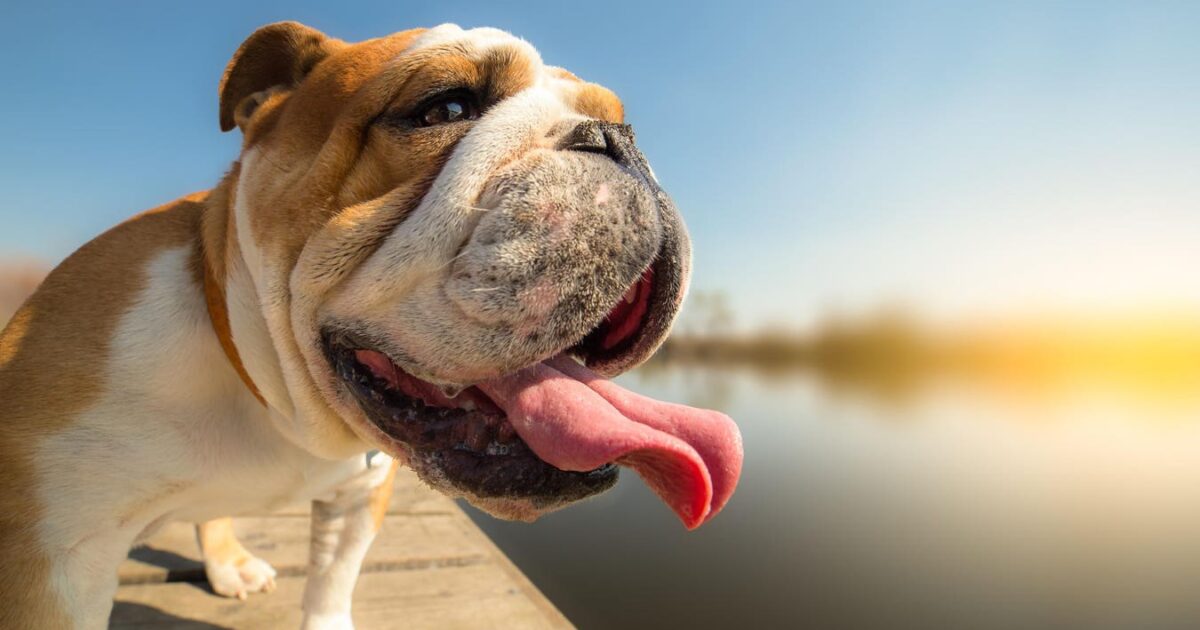Summer Heatwaves Are Dangerous For Pets. Here’s How To Protect Them

Heatstroke poses a danger to dogs and cats during summer heatwaves.
The summer that California resident Christina Jackson and her family adopted a beagle named Buddy, they were excited to take their new dog out for a walk. The previous owners had simply left the dog in a cage in the yard and never taken him for walks. Unfortunately, on his very first walk, Buddy burned his paws on hot concrete.
“He’d never been for a walk and he burned his feet so badly, his little paw pads,” she said. “We couldn’t walk him for two weeks after that.”
Jackson nursed him back to health by covering his feet with a medicated balm and became acutely aware of the need to protect her pets from the hot summer sun and heatwaves. She’s particularly careful when her family heads to Palm Springs each summer with their current dogs, Hank and Bowie, since the desert temperatures average 110 degrees when they go.
Golden retrievers Bowie and Hank love to swim.
“We like to travel with our dogs and since they’re golden retrievers, they love to swim. But the concrete could fry an egg,” she said. “We have put barrier balm on their paw pads, used booties, only walk them in the early morning, and we make a path of wet towels from the backdoor to the pool so they can get into the water without burning their feet. And we’re constantly splashing to keep the whole pool deck wet in case anyone walks on it.”
The Danger Of Heatwaves To Pets
Hot summer weather — particularly during heatwaves — poses dangers to dogs and cats, according to Alexandra Meyer, DVM, veterinarian at VCA Woodbridge Animal Hospital in Woodbridge, Virginia. In fact, her practice has already treated several dogs for heatstroke this summer.
“What a lot of people don’t realize is that dogs and cats regulate their temperature a lot different from humans,” she said. “We go outside and we sweat. We hang around in tank tops and shorts, but dogs don’t have the ability to do that. The only way they can cool themselves off is by panting or by sweating through their feet. They only have sweat glands on their paws.”
Cats are also very sensitive to heat, though since most veterinarians and animal advocates recommend cats live indoors, they can be less at risk during heatwaves than dogs, who need daily walks outside.
The biggest threat is heatstroke, which can lead to seizures or even death. Early signs include excessive panting, drooling, lethargy and weakness.
“All of those signs indicate they might be having some trouble cooling themselves down,” she said. “We may need to get inside to a cool environment with air conditioning if that continues — even seeking out veterinary care. We really, really need to keep an eye on these things.”
“A lot of people don’t realize how temperature sensitive our pets are. Heatstroke is a big, big … More
It bears repeating that it is critically important to never, ever leave a dog or cat alone in a car on a hot day. The recent death of Bruno, an Ohio dog left in a running car with the air conditioning on and cracked windows, is a stark reminder that it’s simply not worth the risk. If temperatures rise above 85 degrees, Dr. Meyer suggests keeping them out of cars altogether.
“If it’s getting to be over 85 degrees, I don’t recommend bringing your dog out on long walks, runs, exercise hikes, even in the car,” she cautioned. “It’s just not safe for these guys.”
Heatwave Prevention Tips For Dogs And Cats
Dr. Meyer knows from clinical and personal experience that we need to take steps to protect our pets from overheating during heatwaves and hot summer weather. She has three dogs — Bennett, Lilli and Odin — and a cat named Thomas O’Malley.
She likes to say that Odin, her pit bull mix, loves to “photosynthesize” by sunbathing as long as possible. So when he’s in the sun, she’s learned to set a timer on her phone and check on him every five minutes to make sure he’s OK.
Dr. Alexandra Meyer sets a 5-minute timer on her phone to check on Odin, her pit bull mix, when he … More
To keep dogs safe on walks during heatwaves, she suggests:
- Walk your dog in the very cool hours of the early morning or evening.
- Bring a water bottle and collapsible water bowl on walks and offer your dog water every five minutes or so.
- If you’ll be walking on asphalt, touch the pavement with your hand. “If you can’t keep your hand there for more than a few seconds, it’s not safe for your dog,” she said. “It’s basically like us walking on pavement with bare feet. Don’t forget that dogs sweat through their feet.”
- Take shorter walks depending on how hot it is and how your dog is faring.
If you suspect your dog is overheating, do not throw them into an ice bath or cold river, which can shock their system.
“What happens is that when we put them in a very cold-water bath or things like that, the blood vessels actually constrict so it becomes harder for them to lose that heat that they’ve retained,” Dr. Meyer cautioned. “So if we do want to cool them down, the best thing is lukewarm water — a lukewarm towel to saturate them in or putting them in a lukewarm bath is the best way to help cool them down. Putting a fan on them with that lukewarm water is going to help cool them even faster and help that evaporation process.”
Protecting Outdoor Pets During Heatwaves
Outdoor cats and dogs need access to fresh water.
If your dog or cat lives outdoors, be sure to check that they have fresh water in a bowl that is full — be sure the water isn’t slimy and doesn’t have bugs in it — multiple times a day.
While dogs who live outside can regulate temperatures a little better than indoor dogs as they’ve gotten used to temperatures climbing, they can still overheat “very, very quickly,” according to Dr. Meyer.
“If they have a doghouse outside, we do recommend that it has some kind of temperature control,” she said. “If we are going to be in the garage, it should be in an AC-controlled garage so that they aren’t overheating.”
Cats should also have access to shade and, ideally, a temperature-controlled environment. People should also be sure to frequently check on cats relaxing on a catio (a cat enclosure on the patio) by setting a 5-minute timer on their phone, she said.
Dogs with a thin fur coat on their belly can benefit from wearing sunscreen made for dogs; there are also canine sunscreen creams to protect their noses.
“They do make pet-safe sunscreen,” Dr. Meyer said. “The only thing, of course, is anytime we put anything on their skin, don’t let them lick it. Give them a few minutes to dry off — give them a snack, give them a meal, a bone chew or a toy to chew on for a couple minutes.”
Enrichment Activities And Other Adjustments During Heatwaves
Normally active dogs who take shorter walks during heatwaves might need to eat a little less food than usual (and be careful not to let them try to supplement their meals with table scraps at backyard barbecues to avoid issues like obstructions or pancreatitis).
But just like when dogs have limited time exercising outside due to wildfire smoke, the most important change is to increase indoor enrichment activities to keep pets’ brains stimulated, according to Dr. Meyer.
Increase indoor enrichment activities for pets during heatwaves when they don’t get as much outdoor … More
Spend extra time with a cat playing with a feather toy or laser pointer, for instance. Try using positive training methods to teach your dog a new trick.
Dogs can benefit from puzzle feeders, like toys from Outward Hound or Kong, or DIY versions. For example, she suggested creating a Kong Wobbler by cutting little holes in an empty 1-liter soda pop bottle and putting kibble or treats inside. Then, the dog can knock the bottle around to try to get the treats to fall out.
“Because we’re not exercising as much, that mental stimulation is really important,” she said. “I like to say that five minutes of mental stimulation is like a 15-minute walk.”

